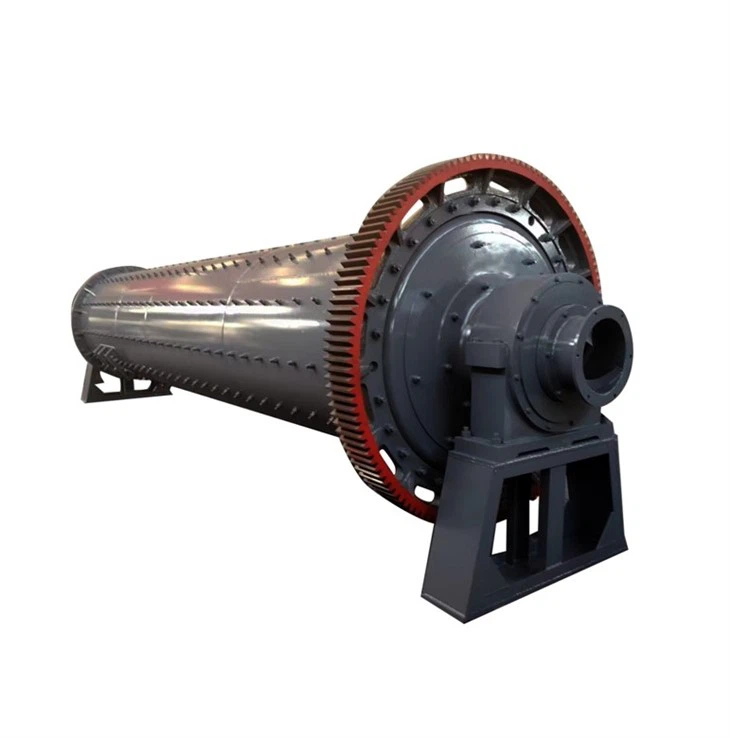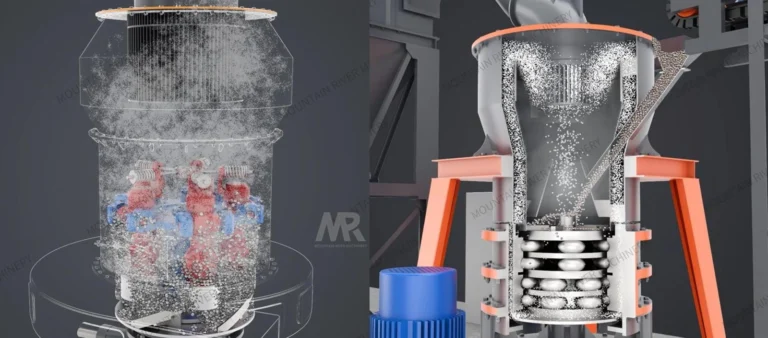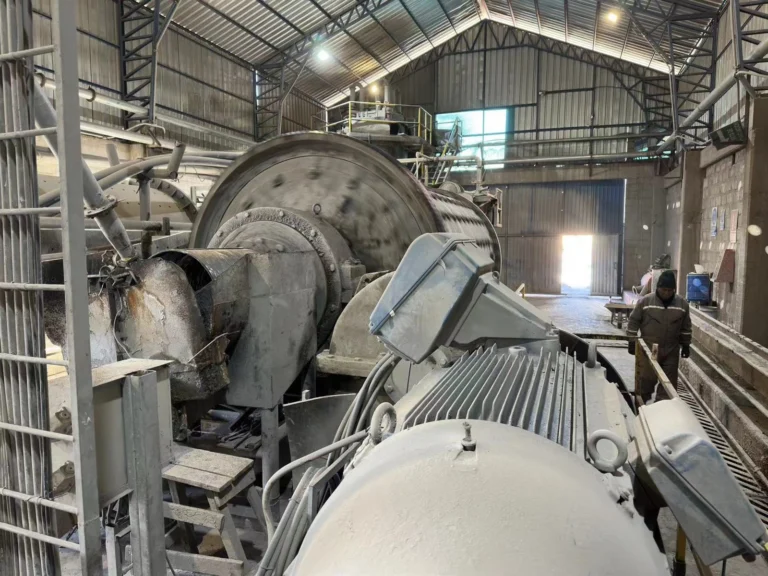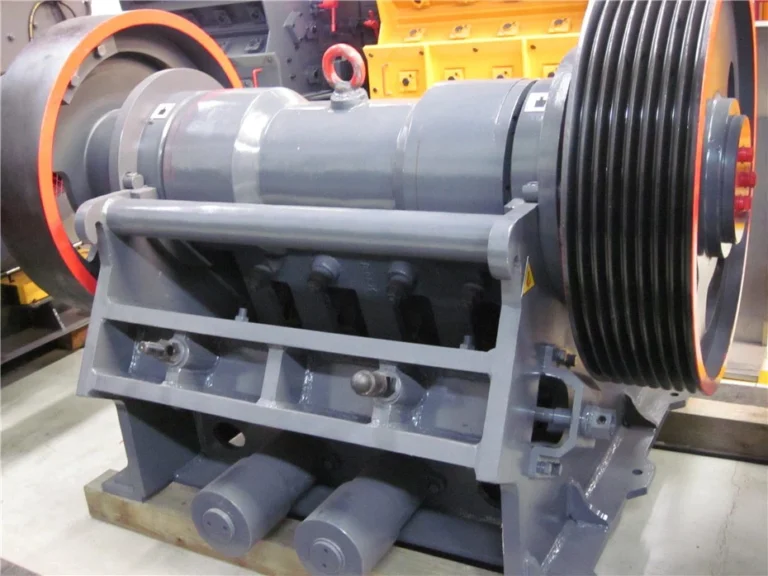Classification of Jaw Crushers
As far as the jaw crusher is concerned, although the structural types are different, their working principle is basically similar, but the trajectory of the moving jaw is different. In summary, when the movable jaw plate periodically reciprocates around the suspension axis to the fixed jaw plate, sometimes approaching and sometimes leaving, when the movable jaw plate is close to the fixed jaw plate, the ore between the two jaw plates is broken by the combined action of crushing, splitting and bending and breaking; When the movable jaw plate leaves the fixed jaw plate, the crushed ore is discharged through the discharge port of the crusher under the action of gravity.
Single Pendulum Jaw Principle
The movable jaw hangs from the mandrel and can be swung from side to side. When the eccentric shaft rotates, the connecting rod reciprocates up and down, driving the two thrust plates to also reciprocate, thereby promoting the moving jaw to do left and right reciprocating motion to achieve crushing and discharging. This kind of crusher adopts crank double linkage mechanism, although the moving jaw is subject to a large crushing reaction force, while its eccentric shaft and connecting rod are not subject to much force, so the industry is mostly made into large machines and medium-sized machines to crush hard materials. In addition, when this crusher is working, the trajectory of each point on the moving jaw is an arc centered on the mandrel shaft, the radius of the arc is equal to the distance from the point to the axis, the upper end of the arc is small, the lower end of the arc is large, the crushing efficiency is low, and its crushing ratio is generally 3-6. Due to the simple motion trajectory, it is called a simple swing jaw crusher.
The simple swing jaw crusher has a compact and simple structure, and the transmission parts such as eccentric shaft are less stressed; Due to the small vertical displacement of the moving jaw, the material is less over-broken during processing, and the wear of the moving jaw plate is small.
The Principle of Compound Swing Jaw
The upper end of the movable jaw is suspended directly from the eccentric shaft, as a connecting rod of the crank linkage mechanism, which is directly driven by the eccentricity of the eccentric shaft, and the lower end of the movable jaw is hinged to the thrust plate to support the rear wall of the frame. When the eccentric axis rotates, the trajectory of each point on the moving jaw is gradually turned into an ellipse by the circumferential line of the suspension point (radius equal to the eccentric distance), and the lower the part, the more deviated the oval, until the trajectory of the point connecting the lower part with the thrust plate is a circular arc. Because the motion trajectory of each point on the moving jaw in this machinery is relatively complicated, it is called a complex swing jaw crusher.
Compared with the simple pendulum type, the advantages of the compound pendulum jaw crusher are: lighter weight, fewer components, more compact structure, better filling degree in the crushing chamber, the loaded material block is evenly crushed, and the lower end of the moving jaw is forced to push out the finished product discharge, so the productivity is higher, and the productivity of the simple pendulum jaw crusher of the same specification is 20-30% higher; The material block has a large up-and-down tumbling motion in the lower part of the moving jaw, which is easy to discharge in the shape of a cube
The jaw crusher is mainly composed of: fixed jaw plate, movable jaw plate, frame, upper and lower protective plate, adjusting seat, moving jaw tie rod, etc. A good understanding of the internal structure of the jaw crusher can play a good role in the use of the jaw crusher and when there are problems.
Crushing Ratio
The crushing ratio is an important evaluation index to measure the jaw crusher, and the crushing ratio of the jaw crusher is the ratio of the particle size of the raw material to the accuracy of the crushed product. It indicates the degree to which the raw material is reduced after crushing. After the ore is crushed, the particle size becomes smaller, and the ratio of the particle size before the ore crushing to the particle size after crushing is called the crushing ratio. It represents the multiple by which the grain size shrinks after the ore is broken. The crushing ratio is calculated as follows:
1. Use the maximum particle size before ore crushing and the maximum particle size after crushing to calculate the maximum particle size method China often adopts this calculation method in the design of mineral processing plants, because the design should determine the width of the jaw crusher feed mouth according to the maximum particle size of the ore
2. Use the jaw crusher to feed the ratio of the effective width of the feeding mouth and the width of the discharge port For some jaw crushers, the discharge particle size is not determined by the size of the discharge opening.
3. Calculated by the average particle size before and after ore crushing, also known as the average crushing ratio
Peculiarity
1. Low noise and less dust.
2. Its crushing ratio is large, and the product particle size is uniform.
3. Simple structure, reliable work and low operating costs.
4. The lubrication system is safe and reliable, the parts are easy to replace, and the equipment maintenance is simple.
5. The crushing chamber is deep and there is no dead zone, which improves the feeding capacity and output.
6. Equipment energy saving: single machine energy saving 15%~30%, system energy saving more than double.
7. The discharge port adjustment range is large, which can meet the requirements of different users.






